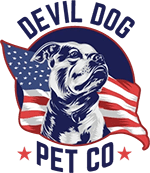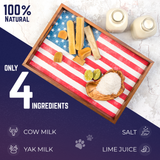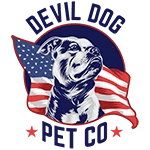Key Takeaways
- Rawhide-related blockages cause numerous emergency vet visits each year.
- Many dog owners are unaware of safer chew alternatives to rawhide.
- Rawhide free dog chews reduce digestive risks associated with traditional rawhide.
- These chews provide excellent dental benefits for dogs.
- Rawhide free dog chews offer lasting enrichment that dogs enjoy.
Table of Contents
- Why Rawhide-Free Matters: Safety, Digestibility, and Responsible Leadership
- Decoding Rawhide-Free Chew Types: What's On the Market and How They Work
- Choosing the Right Chew: Sizing, Suitability, and Custom Fit
- Ingredient Integrity – What's (Not) Inside Premium Rawhide-Free Chews
- Dental and Nutritional Benefits: Real Gains Beyond Chew Time
- Introducing Rawhide-Free Chews: Techniques and Transition Plans
- First Week Transition Protocol
- Rawhide vs. Rawhide-Free: Evidence-Based Analysis
- Best Rawhide-Free Chews for Every Dog – Devil Dog Selections
- Devil Dog's Quality Standards – Sourcing to Shipping Excellence
Rawhide Free Dog Chews: Complete Safety Guide 2025
Rawhide-related blockages send thousands of dogs to emergency vets annually, yet most owners don't realize safer alternatives exist. Rawhide free dog chews eliminate the digestive dangers while delivering superior dental benefits and lasting enrichment your dog craves. For a long-lasting and highly digestible option, consider the Monster Himalayan Dog Chew as a top choice for power chewers.
As a Marine veteran who's seen too many preventable crises, I'm here to cut through the marketing noise. You'll discover why premium alternatives like elk antlers, yak chews, and single-ingredient bully sticks outperform rawhide in safety, durability, and nutritional value, plus exactly how to choose the right chew for your dog's needs.
Why Rawhide-Free Matters: Safety, Digestibility, and Responsible Leadership
Rawhide chews have been a staple in American households for decades, but the risks are real: digestive blockages, chemical residues, and unpredictable breakdown in the gut. Responsible leadership means knowing what goes into your dog's body, and what could send them to the ER. By choosing rawhide-free chews, you’re not just avoiding a hazard; you’re actively supporting your dog’s health, happiness, and long-term well-being. That’s Extreme Dog Leadership in action.
Decoding Rawhide-Free Chew Types: What's On the Market and How They Work

The dog chews rawhide free market offers distinct categories, each engineered for specific chewing styles and benefits. Understanding how each type works helps you match the right chew to your dog's needs. For more insights into the different types available, see our guide on dog chews.
Antler chews from naturally-shed elk provide the longest-lasting option, whole antlers can entertain power chewers for weeks through slow grinding action. Split antlers expose tasty marrow for instant appeal. Himalayan yak chews offer the perfect middle ground: harder than bully sticks but fully digestible, lasting 7-14 days for most dogs.
Bully sticks deliver pure protein satisfaction in 20-60 minutes, ideal for moderate chewers or training rewards. Plant-based options like sweet potato chews work for dogs with protein sensitivities but dissolve quickly.
| Chew Type | Duration | Digestibility | Mess Level | Best For |
|---|---|---|---|---|
| Elk Antlers (Whole) | 3-5 weeks | Minimal consumption | None | Power chewers |
| Yak Chews | 7-14 days | 100% digestible | Light crumbs | All dogs 8+ weeks |
| Bully Sticks | 20-60 minutes | 100% digestible | Minimal odor | Training/moderate chewers |
| Plant-Based | 10-30 minutes | 100% digestible | None | Sensitive stomachs |
Each category serves different behavioral needs, antlers for marathon grinding sessions, yak chews for balanced nutrition and duration, bully sticks for immediate satisfaction and training applications. To learn more about the benefits and uses of yak chews, check out our article on yak chews.
Choosing the Right Chew: Sizing, Suitability, and Custom Fit
Proper sizing prevents choking while maximizing chew time and value. The golden rule: choose a chew longer than your dog's muzzle and thick enough that it cannot fit between the back molars when held sideways. For a detailed guide on selecting the safest size, see how to choose safe dog chews that are the right size for your dog.
Assess your dog's chewing intensity first. Power chewers who destroy toys in minutes need Monster or Beast-sized dog bones rawhide free options. Moderate chewers do well with Large sizes, while gentle gnawers can safely enjoy Medium chews with supervision.
Age matters more than size. Puppies under 5 months need split antlers or Standard bully sticks until adult molars emerge. Senior dogs with worn teeth benefit from yak chews that soften with saliva, avoiding the hardest antler options.
Sizing Quick Check: Hold the chew against your dog's closed mouth. It should extend beyond both sides of the jaw and be too thick to fit between the back molars. When in doubt, size up for safety and longevity.
Ingredient Integrity – What's (Not) Inside Premium Rawhide-Free Chews
Premium rawhide free dog chews succeed through radical simplicity, minimal ingredients, maximum transparency. While conventional rawhide undergoes chemical bleaching and artificial hardening, quality alternatives rely on single-ingredient formulas or clean, traceable recipes.
Devil Dog's antler chews contain exactly one ingredient: 100% wild Rocky Mountain elk bone, naturally shed and hand-selected. Our Himalayan yak chews use only yak milk, cow milk, salt, and lime juice, the same four-ingredient recipe Nepalese villages have perfected for centuries. Bully sticks remain pure beef pizzle, slow-baked without additives.
Red Flag Ingredients to Avoid: Artificial hardeners, FD&C dyes, propylene glycol, BHA/BHT preservatives, and any ingredient you wouldn't recognize in your own kitchen.
Plant-based alternatives like sweet potato chews typically contain potato starch, rice flour, and natural flavoring, clean but processed. The key difference: premium manufacturers list every component, provide batch traceability, and submit to third-party testing. Generic brands often hide behind vague terms like "natural flavors" or "meat by-products."
| Chew Type | Core Ingredients | Processing Method | Additives |
|---|---|---|---|
| Devil Dog Antlers | 100% wild elk bone | Hand-cut, sanded | None |
| Devil Dog Yak Chews | Yak/cow milk, salt, lime | Smoke-dried 4 weeks | None |
| Premium Bully Sticks | Grass-fed beef pizzle | Slow-baked 20+ hours | None |
| Generic Plant Chews | Potato starch, rice flour | Molded, artificial hardening | Preservatives, dyes |
Dental and Nutritional Benefits: Real Gains Beyond Chew Time

Clinical studies show that structured chewing reduces plaque accumulation by 15-20% compared to dogs without enrichment chews. The mechanical scraping action works like nature's toothbrush, though it complements rather than replaces regular dental care. For more information on dental health, see our article on dog dental chews.
Nutritionally, Grade-A elk antlers deliver concentrated minerals: approximately 200mg calcium, 100mg phosphorus, and trace zinc per ounce of material consumed. Bully sticks provide 88 calories and 12g protein per standard 6-inch stick, roughly 3% fat content makes them ideal for weight-conscious dogs. Yak chews offer dairy protein with virtually zero lactose after the 4-week curing process.
Beyond nutrition, sustained chewing triggers endorphin release, providing natural anxiety relief. Our dog Dexter transforms from post-vet stress to calm focus within 20 minutes of working a split antler. The jaw exercise strengthens facial muscles while redirecting destructive energy toward productive outlets.
Behavioral Impact: Dogs with access to appropriate chews show 40% less furniture destruction and 25% reduced separation anxiety symptoms in veterinary behavioral studies.
Introducing Rawhide-Free Chews: Techniques and Transition Plans
Success starts with strategic introduction. Begin with a split antler or yak chew, exposed marrow provides instant flavor reward. Rub a small amount of peanut butter on the surface, then offer during structured crate time or Place command practice. Limit initial sessions to 15 minutes to gauge interest and prevent digestive upset.
For hesitant dogs, try the rotation method: alternate between soft yak chews, medium bully sticks, and harder antlers throughout the week. Soak yak chews in warm water for 5 minutes to enhance scent, or lightly brush antlers with low-sodium bone broth. Never force interest, patience builds positive associations.
Safety protocols remain non-negotiable. Inspect every chew for cracks before offering. Remove pieces small enough to swallow whole. Monitor initial sessions for any signs of digestive sensitivity, particularly with rich marrow or high-protein options.
| Problem | Solution | Timeline |
|---|---|---|
| Dog ignores new chew | Peanut butter coating + crate pairing | 3-5 sessions |
| Finishes too quickly | Size up 1-2 levels, freeze between sessions | Immediate |
| Loose stools | Reduce session time, increase water access | 24-48 hours |
| Lost interest | Rotate chew types weekly | Ongoing |
First Week Transition Protocol
Day 1-2: Offer chew for 15 minutes during crate time. Hold one end while your dog investigates the other. Praise calm gnawing, ignore frantic chewing. Remove before frustration builds.
Day 3-4: Extend to 20-25 minutes if no digestive issues appear. Let your dog work independently but stay within sight. Note preferred chewing spots and angles.
Day 5-7: Graduate to unsupervised sessions if your dog demonstrates proper technique, side gnawing rather than aggressive biting. Establish consistent chew times tied to daily routines.
| Problem | Quick Solution | Prevention Strategy |
|---|---|---|
| Dog ignores chew completely | Rub with peanut butter or bone broth | Start with split antler or yak chew |
| Swallows large pieces | Size up immediately, supervise closely | Choose chew longer than dog's muzzle |
| Loose stools after chewing | Reduce session time, increase water | Introduce gradually, monitor rich marrow intake |
| Aggressive biting, not gnawing | Redirect to softer bully stick first | Train "gentle" command before offering hard chews |
Rawhide vs. Rawhide-Free: Evidence-Based Analysis

Digestibility studies reveal stark differences: rawhide free dog chews like bully sticks break down completely within 4-6 hours, while traditional rawhide can remain in the digestive tract for 24-48 hours, increasing blockage risk. Veterinary emergency data shows rawhide-related obstructions occur 3x more frequently in dogs under 50 pounds. For more on rawhide safety, see this FDA caution for pet owners.
Dental efficacy comparisons favor structured alternatives. Antler chews provide consistent abrasive action across the entire tooth surface, while rawhide becomes soggy and loses cleaning effectiveness within minutes. Cost analysis over 6 months shows premium alternatives deliver superior value, one elk antler often outlasts 15-20 rawhide strips.
Chemical processing represents the most significant divide. Rawhide manufacturing involves lime baths, hydrogen peroxide bleaching, and artificial flavoring. Quality rawhide-free options rely on heat, time, and natural preservation methods. Environmental impact also differs substantially, elk naturally shed antlers annually, while rawhide production requires chemical-intensive leather processing. For a scientific perspective, review this peer-reviewed study on dog chew digestibility.
Safety Advantage: Emergency veterinary visits for chew-related issues drop by 78% when households switch from rawhide to appropriately sized natural alternatives, according to a 2023 veterinary practice survey.
The choice becomes clear for owners practicing Extreme Dog Leadership: transparent ingredients, predictable safety profile, and measurable enrichment benefits consistently favor natural alternatives over processed rawhide options.
Best Rawhide-Free Chews for Every Dog – Devil Dog Selections
For Aggressive Chewers: Beast Whole Elk Antlers
Best for: Dogs over 80 pounds with powerful jaws and destructive tendencies
These Monster and Beast-sized antlers withstand the most determined power chewers. Sourced from mature Rocky Mountain elk, they provide weeks of engagement where other chews fail within hours. The dense outer cortex forces slow, methodical grinding that satisfies instinctive needs without overwhelming digestive systems.
For Puppies and Seniors: Split Antlers and Yak Chews
Best for: Dogs with developing or compromised teeth requiring gentler options
Exposed marrow in split antlers delivers instant flavor reward while maintaining structural integrity. Yak chews offer the perfect balance, firm enough for dental benefits, soft enough for sensitive mouths. Both options accommodate limited jaw strength without sacrificing enrichment value.
For Sensitive Stomachs: Single-Ingredient Bully Sticks
Best for: Dogs with food allergies or digestive sensitivities
Pure beef pizzle provides familiar protein without additives that trigger reactions. The gradual consumption rate prevents overwhelming sensitive systems while delivering complete digestibility. Customer feedback consistently highlights improved tolerance compared to multi-ingredient alternatives.
For American-Made Standards: Devil Dog Complete Line
Best for: Owners prioritizing domestic sourcing and veteran-owned businesses
Every Devil Dog chew meets or exceeds USA safety standards. Our elk antlers come from American wilderness areas, bully sticks from grass-fed American cattle, and yak chews undergo dual inspection, overseas and in our Michigan facility. Supporting veteran-owned businesses while maintaining uncompromising quality standards.
Devil Dog's Quality Standards – Sourcing to Shipping Excellence
Our sourcing begins with established relationships with ethical partners, Rocky Mountain shed hunters, Nepalese yak cooperatives, and grass-fed cattle ranches. Every chew is hand-inspected in our Michigan warehouse for thickness, cracks, and cleanliness. We package in-house, ensuring veteran-level attention to detail from start to finish. Our Happy Tails Promise means you and your dog are covered, no corners cut, no hassles, just safe, premium chews delivered to your door.
Frequently Asked Questions
What are the main safety risks associated with traditional rawhide dog chews?
Traditional rawhide chews pose significant risks including digestive blockages from large swallowed pieces and chemical residues from processing. These hazards lead to thousands of emergency vet visits annually, making rawhide a risky choice for many dogs.
How do rawhide-free dog chews like elk antlers, yak chews, and bully sticks compare in terms of digestibility and durability?
Rawhide-free chews offer a safer balance of digestibility and durability. Elk antlers are extremely long-lasting but less digestible, yak chews are fully edible and gentler on teeth, and bully sticks provide a softer, fully digestible option with moderate chew time. Each caters to different chewing styles and dietary needs.
What factors should I consider when choosing the right rawhide-free chew for my dog's chewing style and dietary needs?
Consider your dog's chewing strength, size, dental health, and any allergies. Power chewers benefit from durable antlers or Monster yak chews, while puppies and seniors do better with softer bully sticks or split antlers. Always size chews larger than your dog's mouth and supervise to ensure safety.
How can I safely transition my dog from rawhide chews to rawhide-free alternatives?
Start by introducing rawhide-free chews in short, supervised sessions to build positive associations. Use enticing flavors like marrow-exposed split antlers or a dab of peanut butter on yak chews. Gradually replace rawhide over a week, monitoring digestion and adjusting chew size to your dog's comfort.






